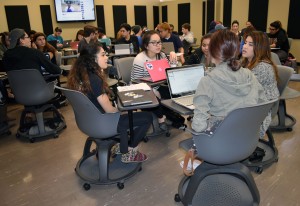 The California State University Chancellor’s Office will be offering grants to faculty members who are interested in redesigning bottleneck courses with proposals due Feb. 15. Formerly known as the Proven Course Redesign and Promising Practices Grant, the grant has been renamed to Course Redesign 2025.
The California State University Chancellor’s Office will be offering grants to faculty members who are interested in redesigning bottleneck courses with proposals due Feb. 15. Formerly known as the Proven Course Redesign and Promising Practices Grant, the grant has been renamed to Course Redesign 2025.
CSU Chancellor’s Office team members Kathy Fernandes, director for Learning Design and Technologies in Academic Technology Services, and Jean-Pierre Bayard, director of Systemwide Learning Technologies and Services, hosted an informational session at SJSU on Nov. 3 for faculty members interested in applying for a grant.
“We are focused on student success and graduation, and we are teaching 21st-century learners,” Fernandes said. “Student surveys say the option to have a learning community is important, but the pedagogy needs to drive the curriculum redesign.”
The grant is open to lecturers, tenure-track or tenured faculty who can apply for up to $15,000. Those who receive awards will participate in a summer institute that brings together faculty from throughout the CSU system and will participate in regular online meetings with their discipline cohort throughout the year. At the end of the grant year, professors have the option to create an e-portfolio to showcase their practices so that other faculty can adopt proven techniques.
“We are hiring a lot of new faculty so it’s a perfect time to transform teaching and learning,” Bayard noted.
Katherine Chilton, a lecturer in the College of Social Sciences Department of History, worked with colleagues Laura Guardino and Rob Cirivillieri in her department to redesign a general education course, “Essentials of U.S. History.” During the informational session, she shared their experience and e-portfolio with colleagues.
“We realized we were not just part of a department, but part of a campus,” she said. “We came together to learn – to see what works and what doesn’t.”
The professors focused on incorporating active learning while emphasizing skills such as reading, writing and analysis in teaching content to students. The courses incorporated active learning, online textbooks, iPads and in-class polling.
“It’s not just a matter of memorizing facts, but the curriculum is more relevant to student’s personal identity,” Chilton said. “We used the same techniques as we would in an upper division seminar, but found ways to do it in lower division (courses.)”
In spring 2016, the team saw an increase in the number of students with passing grades between the redesigned and non-redesigned courses, with 77 percent of students receiving an A or B grade in the redesigned course, compared to 64 percent in the non-redesigned course.